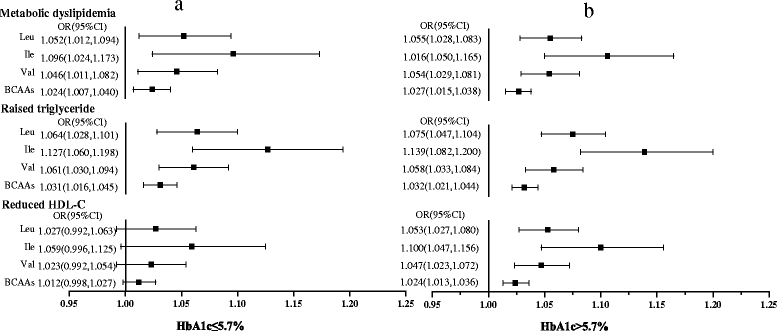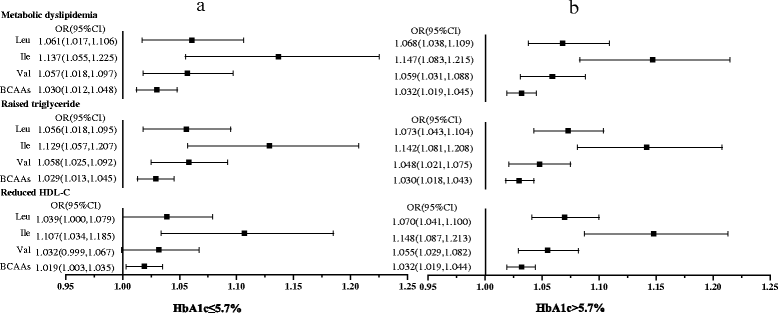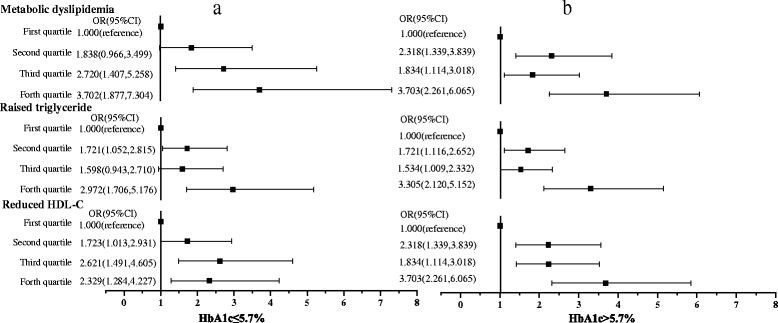The positive association of branched-chain amino acids and metabolic dyslipidemia in Chinese Han population
- PMID: 27457614
- PMCID: PMC4960685
- DOI: 10.1186/s12944-016-0291-7
The positive association of branched-chain amino acids and metabolic dyslipidemia in Chinese Han population
Abstract
Background: It has been suggested that serum branched-chain amino acids (BCAAs) are associated with the incident, progression and prognostic of type 2 diabetes. However, the role of BCAAs in metabolic dyslipidemia (raised triglycerides (TG) and reduced high-density lipoprotein cholesterol (HDL-C)) remains poorly understood. This study aims to investigate 1) the association of serum BCAAs with total cholesterol (TC), TG, HDL-C and low-density lipoprotein cholesterol (LDL-C) and 2) the association between serum BCAAs levels and risk of metabolic dyslipidemia in a community population with different glucose homeostasis.
Methods: Demographics data and blood samples were collected from 2251 Chinese subjects from the Huaian Diabetes Protective Program (HADPP) study. After exclusion for cardiovascular disease (CVD), serious hepatic or nephritic diseases and others, 1320 subjects remained for analysis (789 subjects with hemoglobin A1c (HbA1c) > 5.7, 521 with HbA1c ≤ 5.7). Serum BCAAs level was measured by liquid chromatography-tandem mass spectrometry (LC MS/MS). The association of BCAAs with lipids or with the risk of metabolic dyslipidemia was analyzed.
Results: Elevated serum BCAAs (both total and individual BCAA) were positively associated with TG and inversely associated with HDL-C in the whole population. These correlations were still significant even after adjustment for confounding factors (r = 0.165, p < 0.001 for TG; and r = -0.126, p < 0.001 for HDL-C). For reduced HDL-C, we found higher odds risk (OR) of Valine (Val) in high HbA1c group than in the low one (OR = 1.055, p < 0.001 vs OR = 1.032, p = 0.059). Compared with that in the first quartile, the multivariable-adjusted OR (95 % CI) of the 4(th) quartile of serum total BCAAs level for reduced HDL-C was 3.689 (2.325, 5.854) in high HbA1c group and 2.329 (1.284, 4.227) in low group, for raised TG was 3.305 (2.120, 5.152) and 2.972 (1.706, 5.176), and for metabolic dyslipidemia was 3.703 (2.261, 6.065) and 3.702 (1.877, 7.304), respectively (all p < 0.01).
Conclusion: Elevated serum BCAAs level are positively associated with incident metabolic dyslipidemia. In addition, glucose homeostasis could play a certain role in BCAAs-related dyslipidemia.
Keywords: Branched-chain amino acids; HDL-C; Metabolic dyslipidemia; Triglyceride.
Figures



References
MeSH terms
Substances
LinkOut - more resources
Full Text Sources
Other Literature Sources
Medical
Miscellaneous

